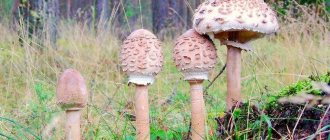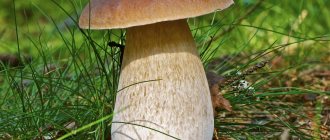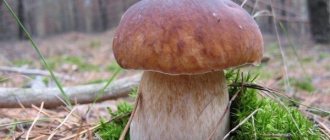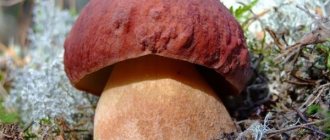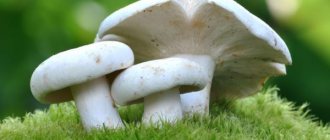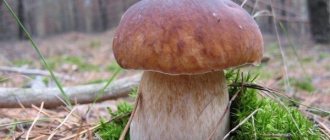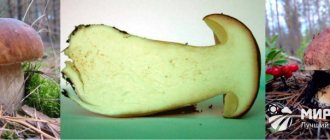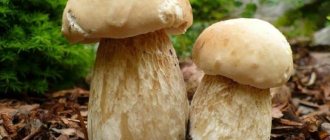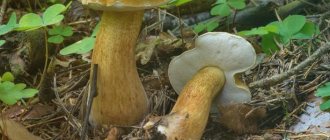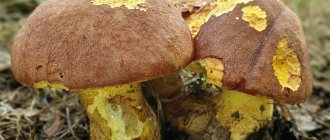The mushroom kingdom has its own king - the Boletus mushroom or the White mushroom. He received this title for a reason. Compared to other mushrooms, Boletus stands out due to its size and taste. It also contains a lot of vitamins and nutrients. Every mushroom picker is happy to find such a mushroom “treasure” in the forest.
The Boletus mushroom grows in almost every forest on the planet except Australia. He prefers the neighborhood of pines, fir trees, birches and oaks.
What does boletus mushroom look like?
At the very beginning, it should be explained how the boletus differs from the white one. Strictly speaking, in scientific terminology, “boletus” is a genus of mushrooms, including about three hundred species, among which there are both poisonous and edible. However, in everyday life, only one species is called boletus. Species is an evolutionarily developed set of individuals characterized by a single... - porcini mushroom. Therefore, later in the article we will use the term “boletus” as a synonym for “ceps.”
The main difficulty in describing the appearance of this mushroom is that it is very variable. Since the white boletus is found almost everywhere in the forests of the northern hemisphere, its appearance can vary significantly. Some scientists distinguish up to 18 subspecies of boletus depending on color, size and ripening time.
Nevertheless, a generalized description of boletus can be given. This is a fairly large mushroom with the diameter of the cap of a mature specimen ranging from 7 to 30 cm (sometimes up to 50 cm). The shape of the cap is convex, hemispherical. Old mushrooms may have a slightly flattened cap, but almost never an open one.
The skin on the cap is dry (matte or shiny) in clear weather; in damp weather it becomes a little slimy. The skin color ranges from red-brown to beige. Moreover, the older the porcini mushroom, the darker the skin. Sometimes there are lemon yellow, orange and purple color options. The skin fuses with the pulp, so it is impossible to separate it.
The pulp is quite dense, fleshy, and becomes fibrous with age. The color of the pulp of young mushrooms is white, then gradually turns yellow, but still remains light. When describing the boletus mushroom, emphasis is always placed on the fact that the flesh does not change color at the cut site. This is the key distinguishing feature of this mushroom. However, in rare cases, a slight blue or pink discoloration of the incision may be observed. The taste of the mushroom is mild, slightly mushroomy. The raw pulp has almost no smell, but a rich mushroom smell appears during the cooking or drying process.
Even a not very large boletus has a very impressive leg: 7-24 cm long (usually no more than 13) and 5-7 cm thick. It is shaped like a barrel or a mace. With age, the leg elongates, becoming cylindrical with a thickened base. The surface is either much lighter than the cap, or the same color, but a lighter shade. Almost always, the leg is covered with a dense network of light veins, especially pronounced closer to the cap.
The layer of tubes at the bottom of the cap is easily separated from the rest of the pulp and is white in young specimens and yellow or olive green in older specimens. There are never any remnants of a “blanket” on the stem, which is also a very distinctive feature of this mushroom.
In general, we can say that boletus is a beautiful mushroom that is difficult not to notice while walking through the forest.
False boletus
Despite the fact that every schoolchild knows what a boletus mushroom looks like, inexperienced mushroom pickers can still confuse it with similar inedible and even poisonous mushrooms.
The gall mushroom is most similar to boletus mushroom. According to scientific classification, it is quite far from the porcini mushroom, but in terms of external characteristics it is quite close to it, for which it received the nickname false boletus. The gall mushroom is not poisonous, but due to its very bitter taste it is still impossible to eat. You can distinguish it from boletus by the following characteristics:
- the diameter of the cap rarely exceeds 10 cm, while the white mushroom is usually larger;
- the flesh turns red when cut, which is not typical for boletus;
- since the pulp is very bitter in taste, the mushroom never becomes wormy;
- the mesh pattern is noticeably darker than the main color of the leg (dark brown or even blackish), while in the porcini mushroom the mesh, on the contrary, is lighter.
Another false boletus, the photo of which you see, is a satanic mushroom. So he is precisely a close relative of the white one, since he is part of the same genus - “Boroviki”. At the same time, the satanic mushroom is very toxic, so it should not be eaten in principle. In most cases, the Satanic mushroom is easy to identify, but sometimes it can closely resemble a real white mushroom. Main differences:
- The color of the cap is never brown. It is usually white, grayish, or olive drab.
- The flesh of the cap is white and noticeably turns blue or red when cut. In the leg of the inedible boletus, the flesh is initially reddish.
- Old mushrooms have a distinctly unpleasant odor.
- The stem of a young mushroom is ovoid or spherical and never becomes cylindrical with age. The maximum is barrel-shaped or turnip-shaped with a narrowing towards the top.
- The main distinguishing feature is the color of the leg. It is usually red or orange. Moreover, the color of the leg is always more saturated and darker than the color of the cap, while for the porcini mushroom the opposite is true.
White boletus: nutritional qualities and traditions of consumption
The nutritional value of porcini mushrooms is not exceptional. Other edible mushrooms are comparable in composition and nutritional value to boletus, or even superior to it. The value of porcini mushroom lies in its excellent taste and ability to stimulate the digestive system.
Since the boletus boletus is found everywhere in Europe and the northern part of Asia, all the peoples of this natural area have culinary traditions associated with this mushroom. Moreover - an interesting detail. Since we are talking mainly about Christian states, where meat is not allowed during religious fasts, but mushrooms are acceptable, boletus mushrooms have become the main substitute for meat products. Many researchers believe that Europeans developed the habit of eating mushrooms mainly thanks to boletus mushrooms, which replaced meat.
In the countries of Eastern Europe, including Russia, one can even talk about some kind of culinary cult in relation to the porcini mushroom. Unlike Western Europe, where there are few forests left and most people have no idea what boletus looks like, we still have many places where wild mushrooms are abundant. In the pre-industrial era, almost every village family stored tens of kilograms of dried and pickled mushrooms for the winter. And the lion's share of them were boletus mushrooms.
Today in Russian villages they continue to dry and pickle porcini mushrooms, although in much smaller quantities. But in cities where three quarters of the population live, this tradition has practically been abandoned. Of course, yellow boletus is still very popular, but it is eaten mainly fried and boiled. Only a few city residents make small stocks of pickled mushrooms for the winter.
Useful and healing properties
Since mushrooms contain a large amount of valuable vitamins, organic acids and chemical elements, they have numerous beneficial properties and are widely used in folk and official medicine. Preparations based on porcini mushrooms provide the following effects on the body:
- Strengthen joints and prevent osteoporosis.
- Fighting anemia.
- Supports the heart muscle.
- Increases hemoglobin content in the blood.
- Stimulates the strengthening of the protective functions of the immune system.
- Prevents the accumulation of cholesterol plaques in blood vessels.
Mushrooms contain components that have powerful antibiotic properties and eliminate E. coli or various forms of tuberculosis. The composition of the product is enriched with riboflavin, which is of particular value in the field of cosmetology.
Adherents of traditional medicine used boletus lotions to treat frostbitten parts of the body. With the help of tinctures you can fight insomnia and nervous excitability.
Boletus mushrooms: what dishes can be prepared
If you have young boletus at your disposal, you can use them entirely. But older specimens usually have a rather hard and fibrous stem that is difficult to chew. However, even it can be put to use: dried and ground into powder for use in sauces, or fried/boiled, and then ground in a meat grinder to then be added to soup and gravy.
Since edible species are an evolutionarily established set of individuals characterized by a single... Boletus mushrooms belong to the first category of mushrooms, they can be eaten in absolutely any form, that is, even raw. For example, Italians add raw boletus to salads. But, of course, mushrooms still taste better when fried or boiled.
Since this is not a culinary site, we will limit ourselves to only a general description of several of the most popular recipes:
- Mushroom julienne. Coarsely chopped boletus mushrooms, no matter how small or large they are, are fried with onions in butter until half cooked, and then sour cream and spices are added to them. After this, the lightly stewed sour cream and mushroom mixture is poured into a pot, covered with grated cheese and briefly put in the oven. It can be served as a separate dish or in combination with meat or mashed potatoes.
- Milk and mushroom soup. Finely chopped, grated, or minced mushrooms and potatoes are first briefly stewed in a frying pan while milk and water are boiled in equal proportions. Then the boletus mushroom and several types of vegetables are added to the milk-water mixture, where they are cooked as a milk-mushroom soup. In this case, you can simply add chopped and separately fried mushrooms, as well as a little semolina.
- Buckwheat porridge with porcini mushrooms. Coarsely chopped porcini mushrooms are placed in a frying pan with pre-fried bacon and onions. The mixture is slightly fried and water, buckwheat and spices are added to it. The dish is stewed until the water has completely boiled away. The finished porridge can be softened with a couple of tablespoons of butter.
- Marinated mushrooms. Mushrooms boiled in salted water are poured with a boiled marinade consisting of mushroom juice, wine vinegar, sugar, salt and spices.
For more information about cooking methods, watch the boletus video .
Porcini mushroom: growing technologies
Although technologies for growing porcini mushrooms have developed so much that they allow one to obtain more or less stable results, according to reviews, porcini mushrooms are not suitable for commercial cultivation. Taking into account the cost of time and resources, their profitability is much lower than that of conventional crops, and therefore they are of interest only as a hobby for amateur gardeners.
The reasons for the low productivity of porcini mushrooms lie in their strong dependence on trees. Only by establishing a strong symbiosis with the root system of a tree can a mushroom colony produce a good harvest. Thus, in order to get serious results, you need to grow porcini mushrooms either in a garden with a large number of trees, or in groves and forest plantations. The best symbionts for porcini mushrooms are oaks, pines, spruces and birches.
In order to plant boletus or porcini mushroom (there is no difference between them), choose an unshaded, moderately moist area. Moreover, the mushroom must be planted strictly under the same type of tree under which the planting material was collected. It is also important to ensure that hoofweed and ferns do not grow nearby.
In order to get a good harvest of mushrooms in the fall, the planting site must be periodically moistened, avoiding drying out, but also without getting too carried away. Watering is carried out once a week. Beautiful fleshy boletus mushrooms, as in the photo and in the description, will appear at the end of summer.
There are two ways to plant mushrooms - seeds (spores) and mycelium.
Where does it grow?
Mushrooms have become widespread. Capable of growing:
- under the fir trees;
- pine trees;
- chestnuts;
- beeches;
- hornbeams;
- oaks;
- in deciduous forests.
You can find them in nature alone and in groups.
We plant boletus with spores (seeds)
Ripe wild mushrooms are used as planting material. Wormy and dried specimens will do just fine. You can determine the appropriate mushroom by breaking the flesh of the cap. If it has a slightly greenish tint, it means the mushroom is ripe for planting.
As follows from the amateur photos and descriptions of boletus, the caps must be thoroughly kneaded until smooth to release as many spores as possible, and soaked in a weak solution of potassium permanganate (1 gram per bucket). You should also add a little sugar (5-6 tablespoons) to the water, which will create a nutritious environment. In this form, the mushrooms should stand for several hours, preferably a day.
In the meantime, we are preparing the landing site. It should be about a meter away from the tree, but in a place where many of its roots pass through. Trying not to damage the root system, you need to remove about 15 cm of the top layer of soil. Planting material is poured directly onto the roots at the rate of 300-400 g. for 20-30 sq. cm. Then the planting site is covered with loosened soil and watered abundantly. If the soil in the area itself is wet, 5-6 buckets of water during planting will be enough. If the area is moderately dry, the planting site needs to be watered periodically, but not very abundantly. Simply moistening the surface layer will be enough. If you overdo it with watering, the spores will simply be washed away from the roots, so when watering it is recommended to pour water on the tree trunk.
to sow boletus at the end of summer, or at the beginning of September, which coincides with the natural cycle of these mushrooms.
First way
In this case, the mushrooms must first be finely chopped. Next, soak the crushed particles in water. Soaking continues for about a day. After this, stirring and straining.
After infusion, the active mass will be ready and can be applied and simply distributed under the trees.
Planting mycelium
An alternative method is to plant a “seedling”, which is a fragment of a mycelium dug in the forest.
A shaded area is selected for the landing site, like the boletus mushroom in the photo. On it, about a month before the planned planting, you need to dig a hole 25-35 cm deep and about 2 m wide, which will immediately have to be filled with a nutrient mixture. The mixture is made from fallen oak leaves collected in the spring, rotted oak wood and clean manure (preferably horse manure). The leaves are laid in layers of about 20 cm, between which thin layers of wood and manure are made. The hole filled in this way should be poured with a one percent solution of ammonium nitrate, and after a week it should be completely shoveled, forming a homogeneous mass.
At the time of planting the mycelium, the mixture is removed from the hole and laid in layers of no more than 12 cm, sprinkled with a slightly thinner layer of ordinary soil. Fragments of mycelium are planted in a checkerboard pattern at a distance of at least 30 cm from each other. (When the mushrooms sprout, you will get excellent pictures of boletus if you photograph the bed)
As for the planting material itself, it is prepared in the form of layers of soil, carefully cut around the above-ground part of the porcini mushroom. Having cut out a block of earth measuring approximately 30x15x15 cm, it needs to be divided into several fragments, which are laid at the planting site to a depth of about 7 cm.
After planting the mycelium, the bed is slightly moistened and covered with foliage, which will retain moisture.
Second way
It will require a whole mycelium. They dig it out very carefully in the forest and additionally it will be necessary to collect forest soil.
Next, a hole is dug under the trees in the place of intended breeding and the mycelium is carefully introduced there.
It is very important to additionally sprinkle not with some fertilized soil, but with forest soil.
